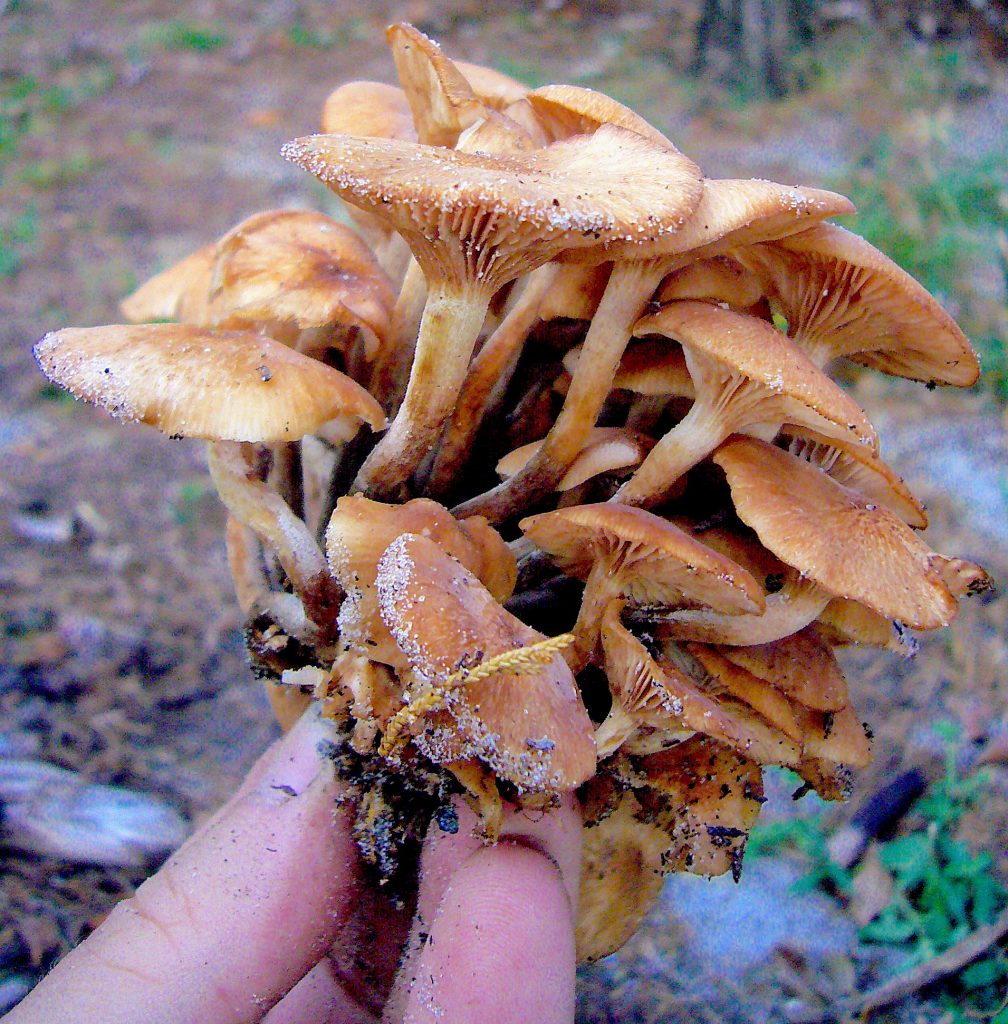
Ringless Honey Mushrooms grow from one crowded spot. Photo by Green Deane
Mother Nature makes up her own rules. That is a veiled reference to shifting seasonality, meaning when plants fruit or make seeds. Locally Mulberries and blackberries are available in April, as are blueberries, Grapes in September, Tallow plums in summer. Seasonal expectation also apply to mushroom (along with the amount and timing of rain.)
I usually see ringless honey mushroom in November, sometime a second season in April. So I had a difficult time believing I found ringless honey mushroom yesterday. As the season was wrong I did not eat them as they were not exacting as the ones I find in November. It didn’t dot all the I’s or cross all the T’s. That is foraging. You develop an expectation for a particular plant. Any thing that gives you cause to pause is reason to stop and re-examine your criteria and judgment. My mushroom was 1) the wrong time of year 2) taller than usual and 3) a lighter color than usual. That all added up to a question mark, and they were tossed out. I don’t need to be sick. Always listen to any doubts you have about a wild edible, be willing to question your judgement, or that of others.
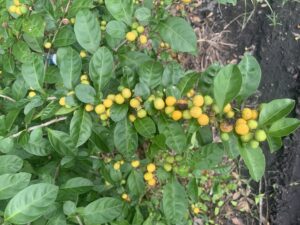
The controversial two-leaf nightshade, Solanum diphyllum. Photo by Green Deane
As mentioned in previous newsletters, a controversial plant is fruiting now, Two-leaf nightshade, A small shrub is universally listed as “toxic.” Adults routinely eat one or two small raw fruits when they find them.The poisoning is dose dependent. A native to Mexico and Central America it was first officially described in Florida in 1966 soon reported suspected in poisoning children and cattle. Edibility aside the species is a source of a highly cytotoxic steroidal alkaloid, 3-O-(beta-D-glucopyranosyl) etioline [(25S)-22,26-epimino-3beta-(beta-D-glucopyranosyloxy) cholesta-5,22(N)-dien-16alpha-ol] which is effective against the cervical cancer cells
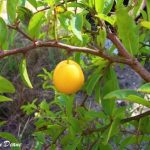
Tallow plums ripen to yellow, and sweeten. Photo by Green Deane
And to be careful don’t confuse the pea-sized diphyllum, upper right, with the larger yellow tallow plum, left, also fruiting now and mentioned in previous newsletters. Like the diphyllum the tallow plum starts out green and ripens to light yellow then dark yellow but is closer in size to a large marble or small plum. The darker yellow it is and softer the sweeter. Out of an abundance of caution the seed and leaves not eaten. Capable of becoming a large spreading shrub with fuzzy blossoms and small thorns the tallow plum fruits from summer into fall. Don’t confuse the names Tallow Plum and Chinese Tallow Tree, which are two totally different species.
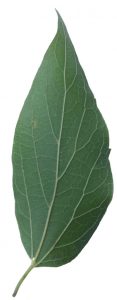
Note the uneven leaf shoulders by the stem and three main veins at the base.
People launch into arguments over the common names of plants. That should not come as a surprise: Botanists get into arguments over the official names of plants. So is the tree a “Sugarberry” or a “Hackberry?” Some will argue the distinction is geographic, other will assert the names apply to different species. I call it a big tree with little burnt-orange fruit that is edible around now. In real estate it is “location, location, location.” Hackberries-Sugarberries like to be near fresh water such as lakes, ponds, streams or a very reliable irrigation-sprinkler system. They don’t like being waterlogged. But you won’t find them on the top of a dry hill either. Usually you can find them up the bank from water. Older trees usually have warty bark, no thorns. Leaves have uneven shoulders, one down or one up, and on the back side of the leaf notice three prominent veins at the base. Often the leaves have many insect galls and or a black smut on them (the latter does not affect the tree or us. It is also found on useable persimmon leaves.) The pea-sized fruit is burnt to medium orange in color sometimes red depending on the species. The entire fruit is edible though the seed is hard. So you can eat the pulp, and or crunch the seed, or mash entire fruits into cakes. To read more about the Hackberry or Sugarberry go here.
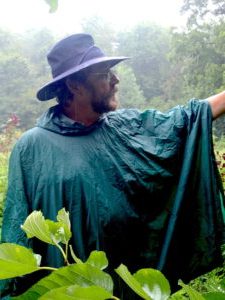
Classes are held rain or shine (but not during hurricanes.)
Foraging Classes: It is that difficult time of year to schedule foraging classes and duck tropical storms. Note there is a class on Labor Day.
Saturday, August 31st, Red Bug Slough 5200 S. Beneva Road, Sarasota, 9 a.m. to noon,
Sunday September 1, Wickham Park: 2500 Parkway Drive, Melbourne, FL. 9 a.m. to noon, meet at the dog park..
Monday, September 2, Eagle Park Lake, 1800 Keene Road, Largo, FL 33771. Meet at the pavilion near the dog park. 9 a.m. to noon.
For more information on these classes, to prepay or sign up go here. The cost is $30 per adult (the class is usually three hours long and examines five-dozen or so species.) If cost is a hardship email me at: GreenDeane@gmail.com.
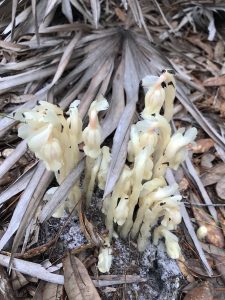
Ghost Pipes, Melbourne Florida. Photo by Green Deane
Several plants were called “Indian Pipes” where and when I was growing up. One of them is the Monotropa uniflora. Living more like a mushroom than a plant it sprouts up in various edibility conversations. It helps focus the issue on exactly what “edibility” means. Other than allergies, edibility does imply it will not kill you or harm you in any significant way. But “edibility” does not have to imply tasty. As forager Dick Deuerling used to say “there are a lot of edible plants. I only eat the good stuff.” There are also things that are just too woody or bitter to eat more than a sample of but are included in “edible.” And some plants have to be prepared correctly to be “edible.” Is the Monotropa uniflora edible? Yes. Does it taste good? Only if you’re really hungry. But that is understandable. The list of edible plants has to include everything from incredibly delicious food to only-if-I-were-starving food. Indian Pipes are closer to the famine food end of that list. You can read more about the Monotropa here.

Green Deane Forum
Tired of Facebook and want to identify a plant? The Green Dean Forum is up and running again. Have you come to dislike Facebook, then join us on the forum. Perhaps you’re looking for a foraging reference? You might have a UFO, an Unidentified Flowering Object, you want identified. On the Green Deane Forum we — including Green Deane and others from around the world — chat about foraging all year. And it’s not just about warm-weather plants or just North American flora. Many nations share common weeds so there’s a lot to talk. There’s also more than weeds. The reference section has information for foraging around the world. There are also articles on food preservation, and forgotten skills from

You get the USB, not the key.
172-video USB would be a good end of spring present and is now $99. My nine-DVD set of 135 videos has been phased out. The USB videos are the same videos I have on You Tube. Some people like to have their own copy. Most of the 172 USB videos have to be copied to your computer to play. If you want to order the USB go to the DVD/USB order button on the top right of this page. That will take you to an order form.
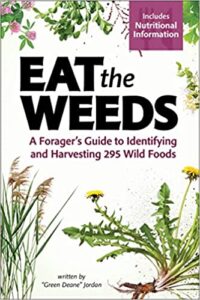
Now in second printing.
EAT THE WEEDS, the book, 274 plants, 367 pages, index, nutrition charts and color photos. It’s available in many locations including Amazon. Most of the entries include a nutritional profile. It can also be ordered through AdventureKeen Publishing.
This is weekly newsletter #609. If you want to subscribe to this free newsletter you can find the sign-up form in the menu at the top of the page.
To donate to the Green Deane Newsletter click here.

